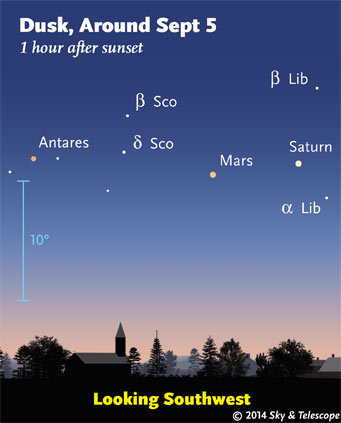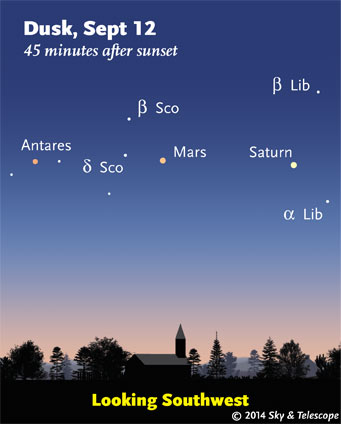
Friday, September 5
Saturn, Mars, Delta (δ) Scorpii, and Antares form an equally-spaced ragged line in the southwest at dusk, as shown at right. Delta Scorpii used to be a bit dimmer than Beta above it. Then in July 2000 it doubled in brightness. It has remained bright, with slow fluctuations, ever since.
Look high above the Moon this evening for Altair.
Saturday, September 6
This is International Observe the Moon night! Zoom in on the map to find an event near you. Or set up your own telescope for the public, and add your event to the map so people can find you! The Moon is waxing gibbous, two days from full. (Just make sure it'll be in view from your site when you tell people to come!) See our article, A Worldwide Night of Moonwatching.
Also, look to the right of the Moon, by a little more than a fist-width at arm's length, for two faintish (3rd-magnitude) stars: Alpha and Beta Capricorni, one above the other. Alpha is the one on top. With sharp vision, you can barely see that it's double. Binoculars resolve it easily.
Sunday, September 7
Look for bright Vega passing your zenith in late twilight, if you live in the world's mid-northern latitudes. Vega goes right through your zenith if you're at latitude 39° north (near Baltimore, Kansas City, Lake Tahoe, Sendai, Beijing, Athens, Lisbon). How closely can you judge this?
Monday, September 8
Full Moon (exact at 9:38 p.m. EDT). The Moon shines in dim Aquarius. To its upper left in the evening, the western side of the Great Square of Pegasus points down toward it (more or less). This is another perigean "supermoon," the third in a row.
Tuesday, September 9
Arcturus is the bright star fairly high due west at nightfall. It's an orange giant 37 light-years away. Off to its right in the northwest is the Big Dipper, most of whose stars are about 80 light-years away.
Wednesday, September 10
The gibbous Moon, still big, rises in the east in late twilight. Look well above it for the bottom corner of the up-tilted Great Square of Pegasus.
Thursday, September 11
A winter preview: If you're up before dawn this week, the sky displays the same starry panorama as it will at dusk early next February: Orion stands high in the southeast, Sirius and Canis Major sparkle to Orion's lower left, Gemini occupies the east to Orion's left, and Jupiter shines far below Gemini's Castor and Pollux. Come February, Jupiter will still be near there.

Friday, September 12
Update: Solar eruption to hit Earth around 8 a.m. EDT Friday morning, possibly causing auroras and other effects. See article: Potent Solar Flare — Auroras Friday?.
Antares, Mars, and Saturn now form an almost equally spaced straight line, as shown at right. Mars continues to move east against its starry background. Watch for it to pass 3° north of Antares on September 27th and 28th.
This evening one of Saturn's moons, 10th-magnitude Rhea, will occult (cover up) a much brighter star, 7.8 magnitude SAO 159034, as seen from North Carolina northward. Telescope users farther south will witness a near miss. Details and illustrations are in our article, See Saturn’s Moon Rhea Hide a Star.
Saturday, September 13
How soon after sunset can you make out the big Summer Triangle? Vega, its brightest star, is nearly at the zenith (for skywatchers at mid-northern latitudes). Deneb is the first bright star to Vega's east-northeast. Altair shines less high in the southeast.
Want to become a better astronomer? Learn your way around the constellations. They're the key to locating everything fainter and deeper to hunt with binoculars or a telescope.
This is an outdoor nature hobby; for an easy-to-use constellation guide covering the whole evening sky, use the big monthly map in the center of each issue of Sky & Telescope, the essential guide to astronomy. Or download our free Getting Started in Astronomy booklet (which only has bimonthly maps).

Once you get a telescope, to put it to good use you'll need a detailed, large-scale sky atlas (set of charts). The standards are the little Pocket Sky Atlas, which shows stars to magnitude 7.6; the larger and deeper Sky Atlas 2000.0 (stars to magnitude 8.5); and once you know your way around, the even larger Uranometria 2000.0 (stars to magnitude 9.75). And read how to use sky charts with a telescope.
You'll also want a good deep-sky guidebook, such as Sue French's Deep-Sky Wonders collection (which includes its own charts), Sky Atlas 2000.0 Companion by Strong and Sinnott, the bigger Night Sky Observer's Guide by Kepple and Sanner, or the beloved if dated Burnham's Celestial Handbook.
Can a computerized telescope replace charts? Not for beginners, I don't think, and not on mounts and tripods that are less than top-quality mechanically (able to point with better than 0.2° repeatability, which means fairly heavy and expensive). As Terence Dickinson and Alan Dyer say in their Backyard Astronomer's Guide, "A full appreciation of the universe cannot come without developing the skills to find things in the sky and understanding how the sky works. This knowledge comes only by spending time under the stars with star maps in hand."
This Week's Planet Roundup
Mercury (magnitude 0.0) remains quite deep in the sunset, as it always does during its evening apparitions that happen in late summer and early fall. Scan for Mercury with binoculars just above the western horizon about 20 minutes after sundown. Don't confuse it with Spica to its upper left.
Venus (magnitude –3.9) and Jupiter (magnitude –1.8) shine in the east during dawn. They continue moving farther apart: Jupiter is moderately high now, and Venus is quite low (to Jupiter's lower left) as sunrise approaches.
Mars and Saturn (magnitudes +0.7 and +0.6, respectively) glow in the southwest at dusk, moving farther apart day by day. Saturn is the one on the right. To Mars's left are fainter Delta Scorpii, and then Mars's starry namesake, Antares.
Uranus (magnitude 5.7, in Pisces) and Neptune (magnitude 7.8, in Aquarius) are high in the southeast and south, respectively, by midnight. See our Finder charts for Uranus and Neptune online or in the September Sky & Telescope, page 50.
All descriptions that relate to your horizon — including the words up, down, right, and left — are written for the world's mid-northern latitudes. Descriptions that also depend on longitude (mainly Moon positions) are for North America.
Eastern Daylight Time (EDT) is Universal Time (UT, UTC, or GMT) minus 4 hours.
“This adventure is made possible by generations of searchers strictly adhering to a simple set of rules. Test ideas by experiments and observations. Build on those ideas that pass the test. Reject the ones that fail. Follow the evidence wherever it leads, and question everything. Accept these terms, and the cosmos is yours.”
— Neil deGrasse Tyson, 2014.
 0
0
Comments
You must be logged in to post a comment.